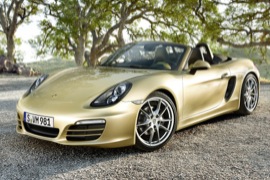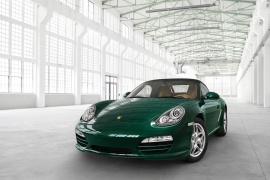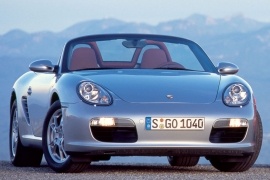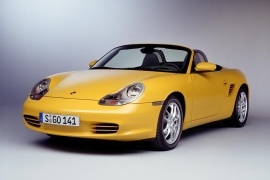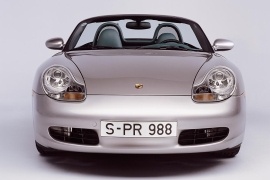PORSCHE Boxster Models/Series Timeline, Specifications & Photos
First production year: 1996
Engines: Gasoline
Body style: Convertible (spider/spyder, cabrio/cabriolet, drop/open/soft top)
Sometimes bigger is better, especially if it is lighter as well, at least in the sports-car segment. The third generation of the Boxster was longer, wider, lighter, and quicker than its predecessor.
The Boxster showed the world that the mid-engine cars might not be as expensive as a Diablo or a Ferrari. It might be even cheaper than the rear-engine 911 and still be fast and fun to drive. That's why Porsche developed the Boxster, a car that shared some of its parts with its bigger, and more notorious, brother.
From the outside, the 2012 Boxster took a different design path than the 911. The round headlights were gone and sleeker, swept, lamps were installed. A typical design element for the Boxster was the front apron, with bigger side-scoops than the central one, which was placed on the lower side. The fenders were still higher than the hood, but not as much as before. In the back, the rounded exhausts were replaced by a large, oval-shaped one. For the opening or close procedure, the Boxster was a true Porsche in terms of speed: it took it only 9 seconds to complete the procedure, at speeds of up to 50 kph (31 mph).
The two-seat roadster featured a clean design interior, with influences from the Carrera GT super sports-car. A new CDR infotainment unit with a 7” touch-screen was fitted as standard on the center stack. There was also a new, 4.6”, multi-function display on the right side of the instrument cluster. As usual, the center position was secured for the analog tachometer.
The 2012 Boxster went through a downsize program and received a 2.7-liter boxer engine, which was 0.2-liter smaller than its predecessor. But the 265 hp were convincing enough for any driver and any naturally aspirated engine lover.
In 2008, the second generation of the Boxster received new technologies and more power. It reached almost the same power as the former Boxster S, from the first generation.
In 2008, the world was still struggling to get out of the economic crisis, but Porsche played well with the Boxster facelift. It was ready updated when the market started to grow again, and it showed the car at the Los Angeles Auto Show.
Besides the new technological improvements, the Boxster received some minor aesthetic changes. The clear headlights were available with LED technology as an option. The rod-shaped turn-signals featured LED technology added distinction to the car's looks, and they were further enhanced by their horizontal arrangement in the outer air intakes. The rectangular fog lights were fitted as standard.
Inside, the Boxster received a new CDR-30 CD radio, with an option for a new Porsche Communication Management and navigation system with hard-drive memory. External devices such as iPod, USB stick, or Bluetooth connectivity were supported as well.
The 2.9-liter unit replaced the older 2.7-liter engine and offered 10 hp more than the older engine. It was not a big difference. It was paired as standard to a 6-speed manual, and a 7-speed PDK (Porsche dual-clutch) automatic was available as an option. The Chrono Package featured the Launch-control system, which allowed the 2002 Boxster to cut an additional 0.1 seconds from the 0-100 kph (0-62 mph) time when compared with the regular PDK version, without the Chrono Package. For better handling, the Boxster was fitted as standard with Porsche Stability Management.
The second generation of Porsche Boxster came out in 2004 at the Geneva Motor Show and shared almost the same design with the first version of the car. However, the first thing you'll notice when comparing the two versions is the redesigned headlights which are similar to the ones installed on the 911 Carrera model. The front air intakes got redesigned, as well as the rear bumper and stoplights. The wheel arches got bigger to allow the installment of bigger rims, while the interior got a more prominent circular theme.
The interior still pointed to the racing heritage with the presence of a tachometer which was the main dial in the instrument panel and the ignition switch was placed on the left side of the steering wheel. The leather upholstery was standard and the trims could be ordered with a choice of materials such as wood, aluminum or wood. The additions list included a Bose sound system, bi-xenon headlights and a navigation system.
The engine was still the same 2.7-liter installed on the facelifted variant unveiled in 2002, producing 240 horsepower and a maximum power of 159 mph. In 2006, the engine got upgraded to generate 5 extra horsepower and also gained a new 6-speed manual gearbox. The new Boxster was produced until 2008 when the German manufacturer presented a new upgrade.
A mild facelift occurred for the first generation of the Porsche Boxster. Some called it a second generation, but it was a change over the same chassis.
The 2002 Boxster came on the market with new engines and new options. It also had a new face, but not that different than the first generation. And while most of the people hoped to have the IMS bearing problem fixed, it was even worse and affected 8% of the cars instead of only 1% for the Boxsters built before 2000. That was caused by the use of single-row bearings instead of double-row bearings.
From the outside, the 2002 Boxster featured an apron with two air-intakes on the sides. It was considered that the centrally-mounted one was useless. Indeed, it was useless unless it looked good. But the manufacturer discovered that later. The small air-intakes on the rear fenders were considered enough for the new engine range. A big improvement was the introduction of a glass rear window instead of the plastic one. A rounded triangular shaped exhaust was placed in the middle of the rear apron.
The 2.5-liter engine was dropped since 2000 in favor of the larger, 2.7-liter unit. For the 2002 model, the flat-six engine in the Boxster received some additional horses and, if fitted with the 5-speed manual, it could get a 0-100 kph (0-62 mph) sprint in 6.4 seconds, almost a second faster than with the 5-speed automatic (Tiptronic).
When it was introduced in 1996, the Boxster was a shock and some considered it as the “poor's man Porsche”. But the mid-engine, rear-wheel-drive, roadster was something different.
Yes, it was cheaper than the 911, but it was nimble and still a daily driver. The smaller engine, the low driving position, and the nimble handling made some 911 owners change their minds and reconsider the base-model from the German car-maker. After all, it was the sequel after the 1969 Porsche 914 but, with the Boxster, they nailed-it!
The design was inspired by former glory models such as the 356 Cabriolet and the 550 Spyder. The front fascia was on the same page with the Porsche 911 – 996 model. The low front end was possible due to the lack of engine and the rear rounded back was possible due to the mid-mounted engine. Two side air-intakes were mounted to feed and cool the water-cooled engine.
For the interior, Porsche took the same approach as with the 911. Even in the base model, the car was fitted with sports seats. The instrument cluster featured fewer dials than its bigger brother, but it still had the speedometer on the left, the rev-counter in the middle, and the water and fuel level on the right round dial. The two security arches behind the seats were not only mandatory but to strengthen the bodywork and stiffen the chassis. For the base model, the sound system was just basic, but it could have been upgraded to a full infotainment unit, with a navigation system.
For the engine compartment, the Boxster was offered with a choice of two engines: a 2.5-liter and a 2.7-liter for the S-version. Both versions could have been ordered with either a 5- speed manual, or a 5-speed automatic transmission.
